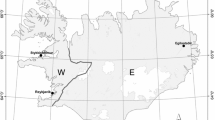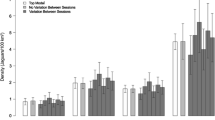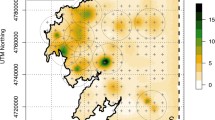Abstract
We have developed a spatially explicit individual-based model that imitates the population dynamics of the Arctic fox on Mednyi Island. In the Red Data Book of the Russian Federation, the Mednyi Arctic fox is listed as an endangered species. The model developed is based on data collected over 19 years of fieldwork. Annual marking of cubs in the study area allowed us to identify up to 80% of animals individually and to collect their life-history data. As a result, we identified the mortality rates of males and females of all age groups, the probabilities of breeding, litter sizes, the sex ratios of animals in different age groups, social structures, dispersion distances, and the patterns of making decisions in the selection of social partners and habitat patches. The model is spatially explicit, i.e., the heterogeneity of the habitat patches is defined in explicit form. The model works with a time step of one year. In simulations, demographic parameters such as population dynamics, population age structure, sex ratio in different age groups, and the structure and size of families conformed to the empirical data. An analysis of the model sensitivity to variations in mortality rates in different age groups showed that the sensitivity to shifts in cub mortality is much higher compared to adults of all age groups. Through increasing the cub mortality rate to 95% over a period of one to five years, we simulated the effect of the otodectic mange epizootic, which was observed in a real population of the Mednyi Arctic fox. The population recovery time after the end of the impact in the simulation was significantly longer compared to field data. We suggest that, in reality, with a low population size, the productivity of the population increases. This feedback that accelerates population recovery has not yet been introduced into the model. In conclusion, we discuss advantages of the individual-based modeling based on long-term field studies.









Similar content being viewed by others
Notes
Most of the individual-based models of animal populations developed in recent decades are spatially explicit (spatially explicit models, Carter et al., 2015; Stenglein et al., 2015; Watkins et al., 2015). This is natural since modern data recording and processing technologies allow us to model the use of spaces and take into account biological processes that depend on space, for example, the landscape distribution of resources. Read more about the features of these models, for example, DeAngelis and Yurek, 2017).
AnyLogic 7.0.2. The AnyLogic Company (former XJ Technologies). For more details: http://www.anylogic.com.
REFERENCES
Bocharova, N., Treu, G., Czirjak, G.A., Krone, O., Stefanski, V., et al., Correlates between feeding ecology and mercury levels in historical and modern arctic foxes (Vulpes lagopus), PLoS One, 2013, vol. 8, no. 5, pp. 1–11.
Carter, N., Levin, S., Barlow, A., and Grimm, V., Modeling tiger population and territory dynamics using an agent-based approach, Ecol. Modell., 2015, vol. 312, pp. 347–362.
Clutton-Brock, T., Long-term, individual-based field studies, in Long-Term Field Studies of Primates, Kappeler, P.M. and Watts, D.P., Eds., Berlin: Springer-Verlag, 2012, pp. 437–449.
Clutton-Brock, T. and Sheldon, B.C., Individuals and populations: the role of long-term, individual-based studies of animals in ecology and evolutionary biology, Trends Ecol. Evol., 2010, vol. 25, no. 10, spec. iss., pp. 562–573.
DeAngelis, D.L. and Yurek, S., Spatially explicit modeling in ecology: a review, Ecosystems, 2017, vol. 20, no. 2, pp. 284–330.
Dzhikiya, E.L., Kolesnikov, A.A., Chudakova, D.A., Zagrebelnyi, S.V., and Goltsman, M.E., Genetic polymorphism of Commander Islands polar foxes Alopex lagopus semenovi Ognev, 1931 and Alopex lagopus beringiensis Merriam, 1902, Russ. J. Genet., 2007, vol. 43, no. 9, pp. 1032–1038.
Dzhikiya, E.L., Ploshnitsa, A.I., Kolesnikov, A.A., and Goltsman, M.E., Genetic monomorphism of the second exon of the DRB1 gene in the major histocompatibility complex of the arctic fox of Mednyi Island (Alopex lagopus semenovi Ognev, 1931), Dokl. Biol. Sci., 2008, vol. 418, no. 2, pp. 37–38.
Enright, J.T., Climate and population regulation. the biogeographer’s dilemma, Oecologia (Berl.), 1976, vol. 24, pp. 295–310.
Goltsman, M.E. and Kruchenkova, E.P., Mednyi Arctic fox (Alopex lagopus semenovi Ognev, 1931), in Krasnaya Kniga Rossiiskoi Federatsii (zhivotnye) (The Red Data Book of the Russian Federation (Animals)), Moscow: Astrel’, 2001, pp. 621–629.
Goltsman, M.E., Kruchenkova, E.P., and Macdonald, D.W., The Mednyi Arctic foxes: treating a population imperilled by disease, Oryx, 1996, vol. 30, no. 4, pp. 251–258.
Goltsman, M.E., Kruchenkova, E.P., Sergeev, S.N., and Volodin, I.A., Arctic fox (Alopex lagopus semenovi Ognev, 1931) of Mednyi Island: ecological features of the island population, Zool. Zh., 2003, vol. 82, no. 4, pp. 514–524.
Goltsman, M.E., Kruchenkova, E.P., Sergeev, S.N., Johnson, P.J., and Macdonald, D.W., Effects of food availability on dispersal and cub sex ratios in the Mednyi Arctic Fox, Alopex lagopus semenovi,Behav. Ecol. Sociobiol., 2005, vol. 59, pp. 198–206.
Goltsman, M.E., Kruchenkova, E.P., Sergeev, S.N., Volodin, I.A., and Macdonald, D.W., “Island syndrome” in a population of Arctic fox (Alopex lagopus) from Mednyi Island, J. Zool. (Lond.), 2005a, vol. 267, pp. 1–14.
Goltsman, M.E., Nanova, O.G., Sergeev, S.N., and Shienok, A.N., The use of food resources by reproductive families of foxes (Alopex lagopus semenovi) on Mednyi Island (Commander Islands), Zool. Zh., 2010, vol. 89, no. 10, pp. 1–18.
Grimm, V. and Railsback, S., Individual-Based Modeling and Ecology, Princeton, New York: Princeton Univ. Press, 2005.
Heppell, S.S., Caswell, H., and Crowder, L.B., Life histories and elasticity patterns: perturbation analysis for species with minimal demographic data, Ecology, 2000, vol. 81, pp. 654–665.
van de Kerk, M., de Kroon, H., Conde, D. A., and Jongejans, E., Carnivora population dynamics are as slow and as fast as those of other mammals: implications for their conservation, PLoS One, 2013, vol. 8, no. 8. e70354. https://doi.org/10.1371
Kirk, C.M., Sentinels of Arctic ecosystem health: polar bear and arctic fox, PhD Thesis, Fairbanks: University of Alaska, 2010.
Kruchenkova, E.P., Goltsman, M.E., Sergeev, S.H., and Macdonald, D.W., Is alloparenting helpful for Mednyi Island Arctic foxes, Alopex lagopus semenovi?, Naturwissenschaften, 2009, vol. 96, no. 4, pp. 457–466.
Mann, K.H. and Lazier, J.R.N., Dynamics of Marine Ecosystems: Biological-Physical Interactions in the Oceans, Oxford: Blackwell, 2006.
Ploshnitsa, A.I., Goltsman, M.E., Macdonald, D.W., Kennedy, L.J., and Sommer, S., Impact of historical founder effects and a recent bottleneck on MHC variability in Commander Arctic foxes (Vulpes lagopus), Ecol. Evol., 2012, vol. 2, no. 1, pp. 165–180.
Ploshnitsa, A.I., Goltsman, M.E., Happ, G.M., Macdonald, D.W., and Kennedy, L.J., Historical and modern neutral genetic variability in Mednyi Arctic foxes passed through a severe bottleneck, J. Zool., 2013, vol. 289, no. 1, pp. 68–76.
Saether, B.E., Coulson, T., Grotan, V., Engen, S., Altwegg, R., et al., How life history influences population dynamics in fluctuating environments, Am. Nat., 2013, vol. 182, no. 6, pp. 743–759.
Shirley, M.D.F., Elmhagen, B., Lurz, P.W.W., Rushton, S.P., and Angerbjorn, A., Modelling the spatial population dynamics of arctic foxes: the effects of red foxes and microtine cycles, Can. J. Zool., 2009, vol. 87, no. 12, pp. 1170–1183.
Stenglein, J.L., Gilbert, J.H., Wydeven, A.P., and Van Deelen, T.R., An individual-based model for southern lake superior wolves: a tool to explore the effect of human-caused mortality on a landscape of risk, Ecol. Modell., 2015, vol. 302, pp. 13–24.
The International Union for Conservation of Nature and Natural Resources (IUCN), The IUCN Red List of Threatened Species, 2009. http://cmsdata.iucn.org/downloads/species_and_climate_change.
Watkins, A., Noble, J., Foster, R.J., Harmsen, B.J., and Doncaster, C.P., A spatially explicit agent-based model of the interactions between jaguar populations and their habitats, Ecol. Modell., 2015, vol. 306, sp. iss., pp. 268–277.
ACKNOWLEDGMENTS
The authors are grateful to all the staff and students of Moscow State University who participated in the collection of field data: N.A. Bocharova, E.L. Dzhikiya, O.A. Filatova, E.S. Gerke, D.M. Glazov, A.M. Goltsman, O.A. Khoroshutina, Yu.I. Mikhnevich, O.G. Nanova, A.I. Ploshnitsa, A.A. Raspopova, L.V. Sagatelova-Pokrovskaya, S.N. Sergeev, A.N. Shienok, I.A. Volodin, E.S. Vorob’eva, and A.V. Zimenko. During editing of the manuscript, the remarks of N.A. Formozov and the anonymous reviewer proved to be very useful.
Funding
The data collection underlying the model was funded in different years by the Faculty of Biology, Moscow State University, the Abolits Fund of Actual Biology, INTAS, the MacArthur Foundation, Fauna and Flora Preservation Society, the Peoples’ Trust for Endangered Species and Task Force (UK), the Russian Foundation for Basic Research, and the Commander Islands State Nature Biosphere Reserve.
Author information
Authors and Affiliations
Corresponding authors
Ethics declarations
The authors declare that they have no conflict of interest. This article does not contain any studies involving animals or human participants performed by any of the authors.
Additional information
Translated by N. Smolina
Appendices
APPENDIX 1
Model parameters
Parameter category | Parameter | Parameter value | Remarks | Source |
|---|---|---|---|---|
Time | Simulation time step | 1 year | All processes and events occurring at time intervals of less than a year are reflected only in abrupt changes in the values of variables when transiting from one step to another | |
Individual | Identification number | Code | ||
Year and place of birth | Birth year and natal den code | Calculated in the course of the work of the model. In the starting state, they are based on empirical data of a long-term field study on Mednyi | Database of long-term field studies on Mednyi Island, L. Doronina | |
Sex | Male/female | Same | ||
Age | From 0 at birth, and growing 1 year with each step | Same | ||
Kin relationships | Collection of relatives: parents, brothers, and sisters, partners in the group | Same | ||
Sites | Location identification | Identification code | ||
Resource value | Whole number from 0 to 3 points (minimum 0, maximum 3) | Abundance of food resources on the site estimated by the size of seabird colonies | Goltsman et al., 2005, 2010 | |
Presence of a den | Parameter equaling 0 (absence of a den) or 1 (presence of a den) | Database of long-term field studies on Mednyi Island | ||
Distances to other sites | km | Based on GIS data | ||
Breeding dens | Location identification | Identification code | Den/shelter of an Arctic fox that had at least once been occupied by a breeding pair over the 20-year period | |
Inhabitants | Collection (list) of the den inhabitants at a given step | Calculated on the basis of prognosis data in the course of the work of the model. In the starting state, based on empirical data of a long-term field study on Mednyi Island | Database of long-term field studies on Mednyi Island, L. Doronina | |
Life-history parameters | Mortality of males | From 0 to 1 | Probability of male death in this age group | |
0-year-old male cubs | 0.593 | |||
1 year old | 0.470 | |||
2 years old | 0.320 | |||
3 years old | 0.350 | |||
4 years old | 0.780 | |||
5 years old | 0.780 | |||
6 years old | 0.780 | |||
7 years old | 0.780 | |||
8 years old | 1 | |||
Female mortality1 | From 0 to 1 | Probability of female death in this age group | ||
0-year-old female cubs | 0.640 | |||
1 year old | 0.164 | |||
2 years old | 0.243 | |||
3 years old | 0.304 | |||
4 years old | 0.400 | |||
5 years old | 0.636 | |||
6 years old | 0.750 | |||
7 years old | 0.750 | |||
8 years old | 1 | |||
Participation of males in breeding | From 0 to 1 | Probability of male reproduction in this age group | ||
1-year-old males | 0.183 | |||
2 years old | 0.611 | |||
3 years old | 0.630 | |||
4 years old | 0.636 | |||
5 years old | 0.330 | |||
6 years old | 0.330 | |||
7 years old | 0.000 | |||
8 years old | 0.000 | |||
Participation of females in breeding | Probability of female reproduction in this age group | |||
0 years old | 0.000 | |||
1 years old | 0.070 | |||
2 years old | 0.480 | |||
3 years old | 0.580 | |||
4 years old | 0.560 | |||
5 years old | 0.530 | |||
6 years old | 0.800 | |||
7 years old | 0.000 | |||
8 years old | 0.000 | |||
Litter size | Whole number ≥0 | Number of cubs in a litter. For the starting year, it corresponds to empirical data. Further, calculated on the basis of empirical distribution of probabilities of different size litters | Goltsman et al., 2005b | |
Sex ratio | From 0 to 1, ratio of males to the total number of animals | Ratio of males to the total number of animals. For the starting year, it corresponds to empirical data. Further, calculated | Database of long-term field studies on Mednyi Island | |
Sex ratio in the litter | From 0 to 1, ratio of males to the total number of cubs | Ratio of males in a litter. For the starting year, it corresponds to empirical data. Further, calculated on the basis of the basic sex ratio 1 : 1 with correction depending on the resource value of the sites | ||
Movements of agents | Choice of the habitation site (home range) in this year | Code of the new site in case of changing it or switching to a nomadic way of life | Probability of home range change for the Arctic foxes of different age and sex is the result of the work of a separate subprogram, implementing the algorithm of selection of a home range from the available collection of vacancies by the Arctic fox. The algorithm (see Model work scheme, paragraphs 10 and 11) is based on empirical data | Goltsman et al., 2005a |
APPENDIX 2
Model interface

Rights and permissions
About this article
Cite this article
Goltsman, M.E., Sushko, E.D., Doronina, L. et al. An Individual-Based Model of the Population Dynamics of the Arctic Fox (Vulpes lagopus semenovi) on Mednyi Island, Commander Islands, North Pacific. Biol Bull Russ Acad Sci 46, 929–945 (2019). https://doi.org/10.1134/S106235901908003X
Received:
Published:
Issue Date:
DOI: https://doi.org/10.1134/S106235901908003X




